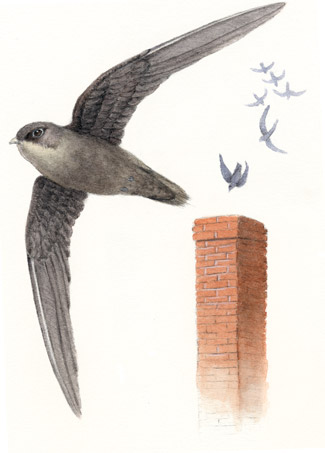Aerially-foraging insectivorous birds have experienced dramatic population declines in North America over the past several decades, but a dearth of data on their limiting factors makes hypotheses about these declines difficult to test. The common link among these declining species is their diet and it is therefore likely that avian population changes are linked to changes in insect prey. We determined that the onset of the population crash for chimney swifts was associated with 1) a major reduction in the amount of beetle and bug prey, and 2) an increased reliance on fly prey. The causes for these changes in prey base remain to be seen, but may be related to historical use of pesticides and contaminants. If chimney swifts serve as a model species for all aerially-foraging insectivores, then our study may have revealed the historical proximate mechanism for their guild-wide decline.
If food has been a limiting factor, an assessment of historical dietary data should show a corresponding change in diet composition and insectivore abundance, however, historical data on most insect taxa are sparse or non-existent. We obtained an unprecedented opportunity to examine such data by assessing historical diet quality through the analysis of a preserved fecal deposit from a major historical chimney swift (Chaetura pelagica) roost at Queen's University in Kingston, Ontario, Canada.
This stratified fecal deposit captures the record of ingested insects from 1928-1998. We removed samples from the deposit in 1 cm increments, and stable carbon (d13C) and nitrogen (d15N) isotopes were analyzed from subsamples. We also collected and identified insect fragments from these subsamples.
Chimney swift populations began a sharp decline in 1965, concurrent with a dramatic reduction in d15N indicating a major change in prey composition was occurring. d15N levels returned to pre-1965 levels between approximately 1977 and 1988, while chimney swifts continued a sharp population decline that has yet to abate. The reduction in d15N levels in the 1960's represents a 50% drop in the trophic status of swifts, a change that could easily affect individual survival and brood-rearing. Our analysis of insect fragments in the fecal archive revealed a strong negative correlation between d15N levels and the per capita amount of remains of Dipterans (flies). Conversely, the per capita amount of remains from Coleopterans (beetles) and Hemipterans (true bugs) was positively associated with d15N levels. Therefore, we determined that the onset of the population crash for chimney swifts was associated with 1) a major reduction in the amount of beetle and bug prey, and 2) an increased reliance on fly prey. The causes for these changes in prey base remain to be seen, but may be related to historical use of pesticides and contaminants. If chimney swifts serve as a model species for all aerially-foraging insectivores, then our study may have revealed the historical proximate mechanism for their guild-wide decline.
Source:Historical declines in chimney swift populations are associated with dramatic changes in insect prey consumption, by
Leah Finity(1), John P. Smol(2), T. Kurt Kyser(2), Matthew W. Reudink(1), Jules M. Blais(3), Chris Grooms(2), and Joseph J. Nocera(4).
(1) Trent University, (2) Queen's University, (3) University of Ottawa, (4) Ontario Ministry of Natural Resources
The 95th ESA Annual Meeting (August 1 -- 6, 2010), Pittsburgh, Pennsylvania
http://eco.confex.com/eco/2010/techprogram/P26280.HTM

- Log in to post comments
